|
 |
| More
QDI KinetiZ 7T Spec's
& Features |
| Sometimes
you get the Bear, and
sometimes the Bear gets
you... |
|
After close
examination of the feature set, as well
as the 7T's layout, one might be lead to
believe that QDI has quite the little
screamer on their hands. At least,
that's what I thought. Especially after
I realized that the KinetiZ 7T is
supposed to have the ability to change
the multiplier, on unlocked Socket A
CPUs. Just try and imagine my joy when I
found this out and casually glanced at
my two Duron's and noticed they both
happened to be unlocked... (trust me, I
almost started weeping...). More on the
topic of overclocking later. I'm going
save the juicy stuffs for last.
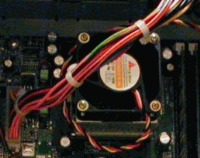 As
far as the rest of the features/layout
are concerned, the 7T isn't really that
spectacular. It would have been nice to
see the power supply connector located
somewhere that wouldn't force the wire
bundle to run over the top of the CPU,
restricting airflow. The 7T's AMR Slot
could also have been placed in a more
useful location (the toilet comes to
mind...) below the AGP port, As
far as the rest of the features/layout
are concerned, the 7T isn't really that
spectacular. It would have been nice to
see the power supply connector located
somewhere that wouldn't force the wire
bundle to run over the top of the CPU,
restricting airflow. The 7T's AMR Slot
could also have been placed in a more
useful location (the toilet comes to
mind...) below the AGP port,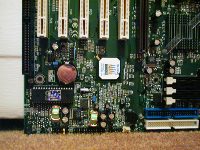 rather then above it. Depending on the
type of full length PCI cards you're
using, the 7T can either accommodate 5
full length PCI cards, or just 1. You
see, all but the first PCI slot has some
sort of object near it, that may, or may
not get in the way. It all depends on
how far your PCI cards extend below the
actual PCI slot. 12 meg Voodoo2 users
shouldn't have a problem,
thankfully. Not that I
actually use more then three PCI slots,
but it's nice to know that I could, if I
wanted to.
rather then above it. Depending on the
type of full length PCI cards you're
using, the 7T can either accommodate 5
full length PCI cards, or just 1. You
see, all but the first PCI slot has some
sort of object near it, that may, or may
not get in the way. It all depends on
how far your PCI cards extend below the
actual PCI slot. 12 meg Voodoo2 users
shouldn't have a problem,
thankfully. Not that I
actually use more then three PCI slots,
but it's nice to know that I could, if I
wanted to.
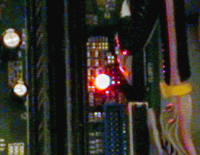 I'm
going try and get off the negatives for
a bit and concentrate on a few of the
7T's more positive notes. My favorite positive
on the 7T, is it has this nifty red
LED... It is there to let you know when
there's power going coursing through it.
I'm guessing that's in the event you
don't notice the whirling fans. Hey, far
be it from QDI to assume that their
customers have IQ's higher then that of
your average tree frog. Speaking of
fans, the QDI folks were nice enough to
include three fan headers (two RPM
monitoring), in all the right places.
This is something I'd definitely like to
see more of, as two seems to be the more
common number of fan headers on other
Socket A motherboards. QDI's
implementation of VIA's hardware
monitoring is quite good as well. There
are two thermal sensors built into the
motherboard, one directly beneath the
CPU, and one down in the lower right
corner of the board. I'm
going try and get off the negatives for
a bit and concentrate on a few of the
7T's more positive notes. My favorite positive
on the 7T, is it has this nifty red
LED... It is there to let you know when
there's power going coursing through it.
I'm guessing that's in the event you
don't notice the whirling fans. Hey, far
be it from QDI to assume that their
customers have IQ's higher then that of
your average tree frog. Speaking of
fans, the QDI folks were nice enough to
include three fan headers (two RPM
monitoring), in all the right places.
This is something I'd definitely like to
see more of, as two seems to be the more
common number of fan headers on other
Socket A motherboards. QDI's
implementation of VIA's hardware
monitoring is quite good as well. There
are two thermal sensors built into the
motherboard, one directly beneath the
CPU, and one down in the lower right
corner of the board.
OK,
that's all there is, as far as the positives
are concerned... The 7T has just way too
many negatives to ignore. Remember when
I said that the KinetiZ 7T had what
every overclocker dreams about? Ahhh
yes, of course you do... The ability to
adjust the multiplier natively. Whoo
Hooo!!! Right? Well, not so fast there
partner. First, there's two
separate jumper blocks, and a total of 9
different sets of jumpers to adjust.
OK, so
that's not really a big deal. I guess no
one at QDI's ever had the pleasure of
using an EPoX board, with it's single
jumper multiplier adjuster. Or maybe
they've never had the blissful
experience of toying with Abit's
SoftMenu™ III. But hey, they did give
us the ability to change the multiplier,
so I should stop my girlish whining,
right? Of course I should... But alas, I
cannot. You see, this feature didn't
work! So, sorry kids, I
tried two different unlocked Durons (650
and 700), and no amount of multiplier
changing, up or down, resulted in
anything resembling a computer booting
up, let alone a post screen. Not that
you'd be able to do much multiplier
changing, in the first place. It seems
QDI conveniently forgot to add the
ability to change the voltage. I
guess they don't do too much
overclocking over there. Probably a
government thing. So, I'm sorry to tell
you this but you aren't going crank that
600MHz Duron up to 1GHz, on the KinetiZ
7T. All though, it is good to see that
the QDI engineers have a bit of a sense
of humor, as they gave the 7T the
ability to crank the FSB up to 166MHz
(Ha! Good luck there tough guy...).
So then, is that it as far as the
negatives are concerned? You getting
tired of my whining yet?
Well....... I did have one more, minor issue,
with this here motherboard (You guys
really don't know how bad I wanted to
like this board). You see, the primary
IDE port (IDE1) decided it was about
time it started doing it's own thing. It
pretty much quit on me. And when I tried
to get it to work, it would get all
hostile with me (Something I'm just not
used too...). It really didn't matter
what I plugged into it, CDROM, ATA66,
ATA33.... It just flat out wouldn't work
correctly. No bootage, and the bios
would misidentify anything I stuck in
there. As you can plainly see, in the
first two bios shots.
|
Correct
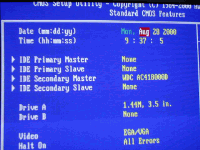 |
Not
so correct
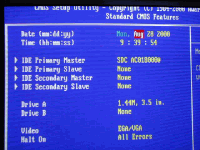 |
|
Other
Settings Used |
|
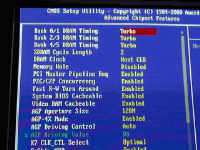
|

|
Now that
I've stepped into the bios, I might as
well point out one other minor grievance
I had with the KinetiZ 7T. The 7T is the
first KT133 motherboard I've used, that
couldn't run my Samsung -GH SDRAM at
133MHz. It didn't matter what the other
settings consisted of, the 7T absolutely
refused to run with the memory set to
+33MHz. Surprisingly, this didn't hold
the benchmarks back to much. This is
partly due to the 7T defaulting to 4 way
Bank Interleave.
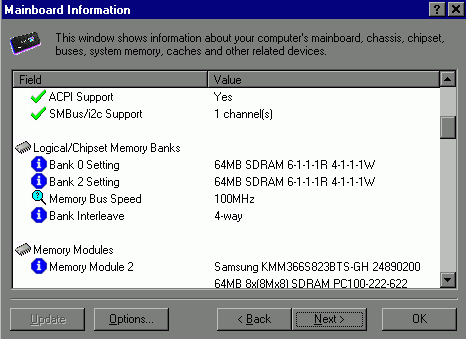
|